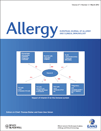Cutaneous lymphocyte antigen and α4β7 T-lymphocyte responses are associated with peanut allergy and tolerance in children
Edited by: Bodo Niggemann
Abstract
Background:
It is unclear whether the initial route of allergen exposure in early life could influence the subsequent development of allergy, with cutaneous sensitization leading to peanut allergy (PA), and tolerance induced by oral exposure. The skin- and gastrointestinal (GI)-homing markers, cutaneous lymphocyte antigen (CLA) and α4β7 integrin, are used to determine whether the state of PA correlates with peanut-specific CLA responses, with tolerance associated with predominant α4β7 responses.
Methods:
CLA+ and α4β7+ memory T cells were isolated and cultured with peanut extract to assess their proliferation. Stimulation indices were compared in peanut allergic and non-allergic (NA) groups, and peanut-specific cytokine production was measured.
Results:
In peanut allergic patients, peanut-specific proliferation predominates in the skin-homing CLA+ subset, whilst peanut-tolerant groups have a mixed CLA/α4β7 response (P = 0.008). Comparison with a control food antigen (ovalbumin) showed that these differences are allergen specific. Cytokine responses showed trends towards Th1 skewing in the GI-homing α4β7+ cells of peanut-tolerant groups and Th2 skewing in the skin-homing CLA+ cells of peanut allergic patients.
Conclusion:
The predominance of the CLA+ response to peanut in peanut allergic patients is consistent with the hypothesis that allergic sensitization occurs through the skin. The predominant α4β7+ response in peanut-tolerant groups suggests that allergen exposure through the GI tract induces tolerance.




